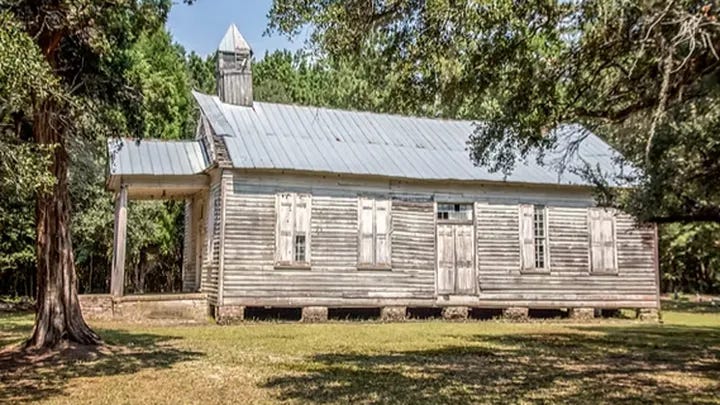#146: South Carolina's Lost Architectural Treasures + More SC History Camps!
For South Carolina history lovers far and wide! Published weekly on Monday mornings. Enjoy weekly SC history articles, upcoming SC historical events, and other South Carolina recommendations.
Dear readers,
I have wonderful news!
Thanks to your generous donations, we have achieved our $200 GoFundMe goal towards the preservation of the historic Taveau Church, one of the last remaining Antebellum historically black churches remaining in South Carolina. A bit about the structure’s significance.
"Taveau’s restoration, however, is about more than just preserving a historical structure because of its unique architecture. It would also be a testament to the faith of the Black men and women who preserved Taveau as a place for their worship and coincidentally, passed down 175 years of Black worship experience including inspired preaching and soulful spirituals. Taveau tells this important story as well as the story of the local area, its land, its people, and its culture."
—Reverend Clayton J. Jones, Sr.
The funds will now be transferred to the Palmetto Trust for Historic Preservation, which oversees the restoration of Taveau Church.
Thank you for your continued support of the SC History Newsletter and projects like this that help us preserve historic structures for future generations to come!
That sentiment flows perfectly into the subject matter of today’s newsletter: South Carolina's Lost Architectural Treasures. I had a lot of fun researching these lost gems. I hope you enjoy.
Now, let’s learn some history!
Yours truly,
Kate
(Writing from Greenville, SC)
Support the SC History Newsletter by considering heritages teas (inspired by South Carolina and American history!) from our fantastic sponsor Oliver Pluff & Co. — click on their beautiful ad below! :)
➳ Housekeeping for new subscribers!
New friends! There are over 100 previous SC History newsletters on topics ranging from the founding of Charleston, sunken Confederate submarines, railroad tunnels filled with blue cheese, and more! See our archive here!
Send me your comments or topic ideas: I love it when subscribers write to me! Have a SC History topic or question you’d like for me to write about? Have additional ideas or feedback? Just reply to this email and let me know!
Join us on social: Keep the conversation going and join over 100 other subscribers by becoming a member of our SC History Newsletter Facebook Community here!
If your email “cuts off”: In your email app or website, if my emails “cut off” for you, please click the title of the email and it will take you to the full post on the Substack. I don’t want you to miss any content!
Love the SC History Newsletter? Please click the button below to share with a friend!
➳ Featured Upcoming SC History-Themed Summer Camps
Note: Based on the awesome SC history-themed camp I found last week, I went hunting for more!
🗓️ Elementary School Camp | 3rd – 5th Grades | June 2-6, 2025, 9am to 4pm
🗓️Middle School Camp | 6th – 8th Grades | June 16-20, 2025, 9am to 4pm
📝 Hidden History Camp
📍Clemson University | Clemson, SC
🎟️Fees for both camps are $185. A $25 deposit is required at the time of registration, and a balance of $160 is due by May 23, 2025.
💻 Website
From the camp website:
This summer, Clemson is offering two one-week day camps, one for elementary school students and one for middle school students, about Hidden History at the University! We offer a variety of interactive activities for campers, including historic site tours, archaeology digs, explorations of the archives, and family history activities, all arranged to provide an unforgettable summer camp experience right on campus!
🗓️ June 9th-13th, 9am-12pm
📝 Archaeology Camp
📍Walnut Grove Plantation | Spartanburg, SC
🎟️$150, Ages 6-12
💻 Website
From the camp website:
Let's dig into history with a hands-on exploration into the field of archaeology.
Campers will explore the footprints of former buildings at Walnut Grove Plantation and examine artifacts found on previous digs. We will learn about archaeological excavation and reasoning used on digs. We'll discuss local and some of the world's most famous finds, such as Egyptian mummies and fossilization!
Featured last week but wanted to feature once again in the larger list!
🗓️June 16th-20th, 9am-12pm
📝 American History “Spy Camp”
📍Walnut Grove Plantation | Spartanburg, SC
🎟️$150, Ages 6-12
💻 Website
From the camp website:
“Embark on a journey into the world of Revolutionary War espionage at Spy Camp.
Campers will uncover the secrets of 18th-century spycraft, from creating disguises and cracking codes to navigating stealth missions and decoding enemy plans. Through hands-on activities and covert operations, kids will step into the shoes of Patriot spies and experience the excitement of history in action.”
🗓️ July 7th-11th, 9am-12pm
📝 Trailblazers Camp
📍Walnut Grove Plantation | Spartanburg, SC
🎟️$150, Ages 6-12
💻 Website
From the camp website:
Step into the shoes of 18th-century pioneers and discover the challenges and triumphs of life in the South Carolina Backcountry.
Campers will learn essential survival skills, discover the value of community and self-reliance, and connect with nature through hands-on activities inspired by early settlers. Children will experience the ingenuity, teamwork, and resilience that defined early settlers of the Upstate. This journey into the past is perfect for young explorers ready to blaze their own trails!
➳ 🗓️ Paid subscribers get access to my SC History Events Calendar that organizes all the upcoming SC history events I have discovered. Please let me know if you’d like to add an event to the calendar! Reply to this email to send me your events.
➳ South Carolina's Lost Architectural Treasures
South Carolina is home to countless historic architectural treasures, but over the years, natural disasters, the Civil War, changing economic tides, and other forces have led to the destruction or decay of many once-stunning structures. Join us as we explore a few of these lost landmarks!
The Forgotten Mansion of Millwood Plantation (Columbia, SC)
Construction and Ownership: Built circa 1830, Millwood was a Greek Revival mansion owned by Colonel Wade Hampton II. It served as the boyhood home of Wade Hampton III, who later became a Confederate general and South Carolina governor.
Social Hub: Millwood was renowned as the "social center of South Carolina" during the antebellum period, hosting prominent figures such as Henry Clay and Daniel Webster.
Destruction: On February 17, 1865, Union troops under General Sherman burned Millwood during the Civil War. Today, only a few columns and remnants remain of this grand and historic mansion.

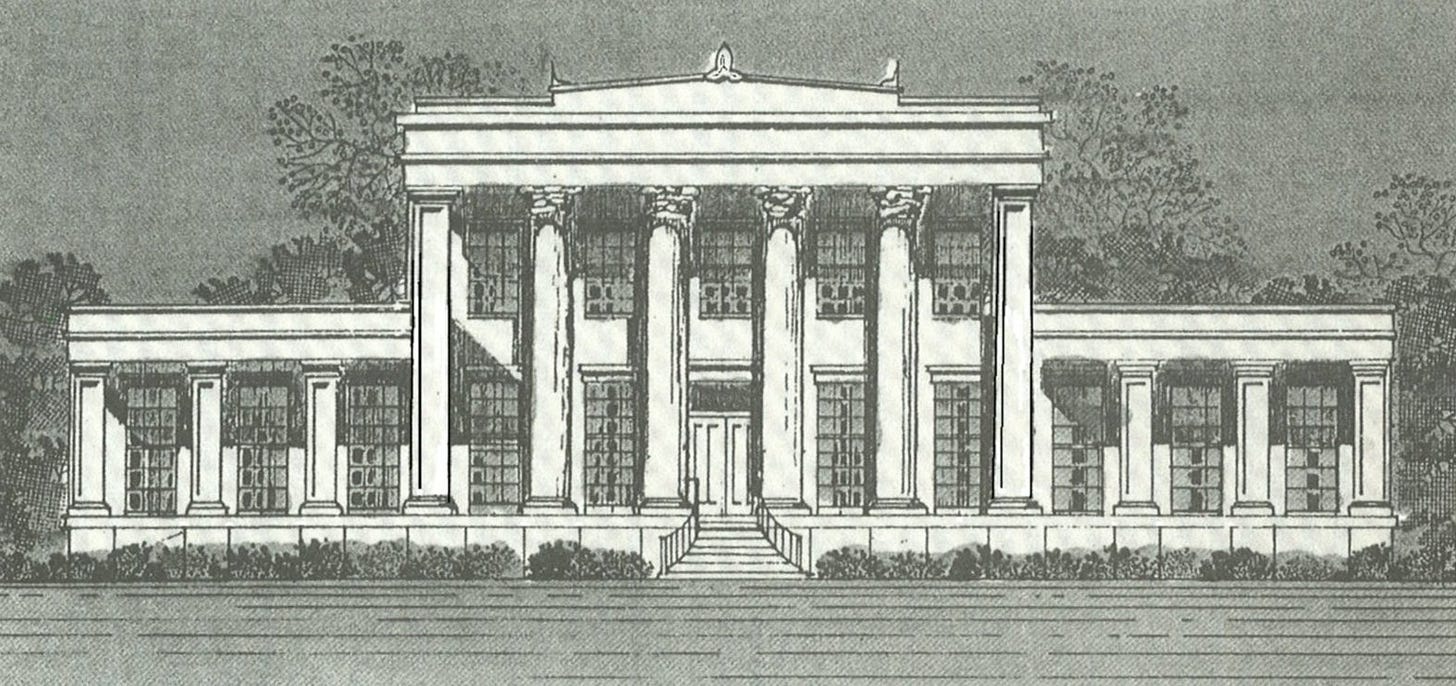
The Ocean Forest Hotel (Myrtle Beach)
Grand Opening: Opened on February 21, 1930, the Ocean Forest Hotel was a ten-story, Neoclassical structure designed by Raymond Hood, known for his work on New York's Rockefeller Center.
Luxury Resort: Commissioned by textile magnate John T. Woodside, the hotel was part of the envisioned "Arcady" resort, aiming to attract America's elite. The hotel “featured 202 ventilated guest rooms, indoor and outdoor pools, a lighthouse spire, salt or fresh running water, colonnaded marble verandas and magnificent Georgian ballrooms tinseled with 20-foot chandeliers crafted by Europe’s finest crystal makers.” Each hotel bathroom was equipped with hot, cold, and saltwater tub spigots, which was very luxurious in the 1920s. Topping off the white wedding-cake-esque design was a lighthouse spire used for coastal navigation. The tower was also the site of Myrtle Beach’s “first radio station, as well as a reputed gambling venue.” Guests and members enjoyed the beautiful Robert White-designed 27-hole golf course, which was the first golf course in Myrtle Beach. Also overlooking the ocean, an open-air amphitheater was built, which locals called the “Marine Patio.” Back in its heyday, locals savored the dance music of all the famous big bands: “Carmichael, Dorsey, Basie, Spike Jones, Herman, Harry James, with the silvery ocean as a romantic backdrop.”
Demolition: Due to high operating costs and changing tourism trends, the hotel was demolished on September 13, 1974. Myrtle Beach restauranteur Dino Thompson said of the demolition:
“All that’s left of what shoulda been our Breakers, our Greenbrier, our Fairmont, our Plaza Hotel…are just a few artifacts, some postcards, concrete roads, the Pine Lakes Golf Course and pangs of what mighta been, coulda been, shoulda been.”

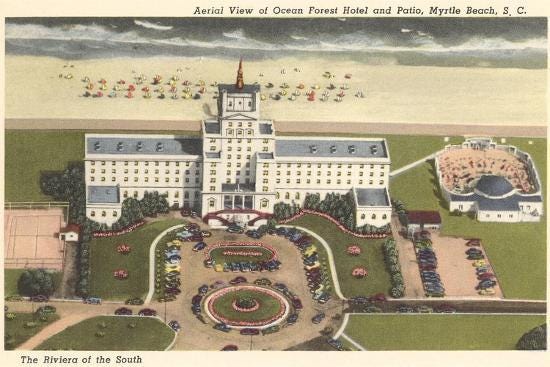

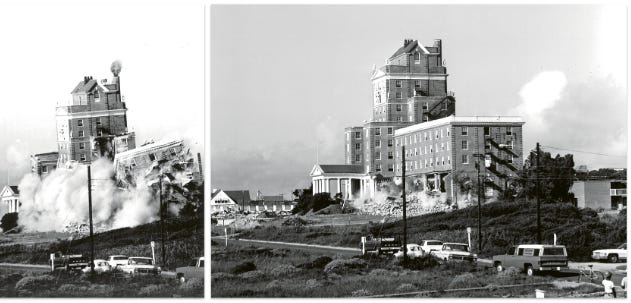
The Disappearing Hotels of Greenville
19th Century Golden Era: In the 19th century, Greenville, SC featured several prominent hotels, including:
The Mansion House (Opened 1820s - Demolished 1924 to make way for the construction of the Poinsett Hotel)
Ottaray Hotel (Opened 1909 – Demolished 1962)
Altamont Hotel (Opened 1889 - Destroyed by a fire in 1920)
The Planter’s Hotel (Opened 1823 – Demolished mid-1800s).
These grant hotels housed tourists in an era when Greenville was a popular summer resort destination, especially for Lowcountry residents seeking relief from the oppressive coastal heat, drawn by the area's cooler mountain air and scenic vistas.
Civil War Impact: Many of these hotels, such as the Planter's Hotel, did not survive the Civil War, leading to a decline in Greenville's hospitality industry.
Modern Revitalization: The Westin Poinsett Hotel, originally opened in 1925, was restored and reopened in 2000, symbolizing Greenville's downtown revitalization. Thankfully, this architectural gem has not been demolished and still stands proudly at the heart of downtown Greenville, serving as a vibrant focal point of the city!

Ottaray Hotel (where the Hyatt Regency now stands) at the corner of North Main Street and Oak Street in downtown Greenville, SC (Image Source) 
The Altamont Hotel on Paris Mountain (Image Source)
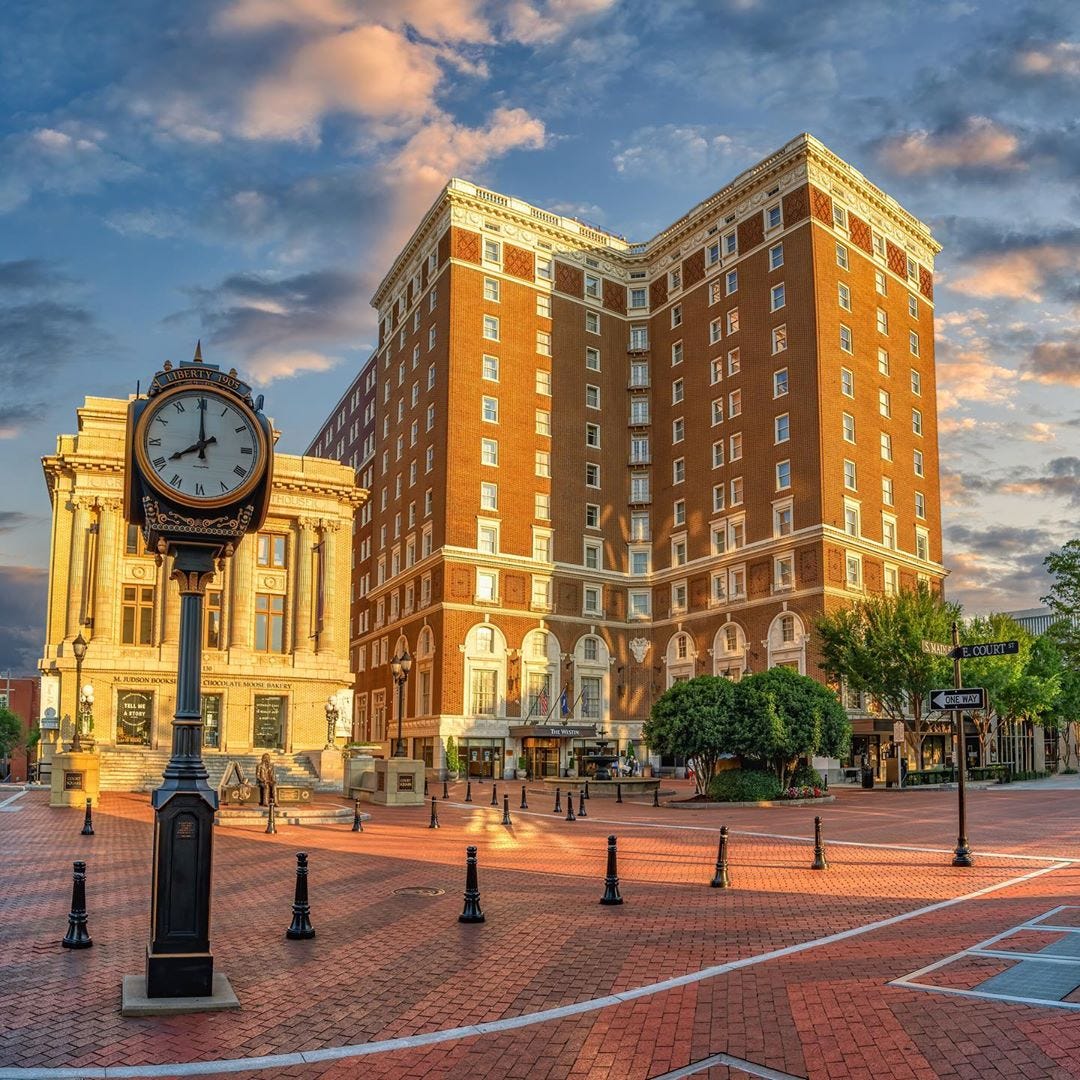
The Vanishing Schools of Rural South Carolina
Rosenwald Schools: Between 1917 and 1932, over 5,000 Rosenwald Schools were built across the South to improve education for African American children, with 500 built in South Carolina.
Decline: With desegregation and modernization, many of these schools were closed, sold, or left to deteriorate.
Preservation Efforts: Some communities have worked to restore and preserve remaining Rosenwald Schools as historical landmarks. Visit the SC Rosenwald Schools Trail to learn more about preservation efforts.
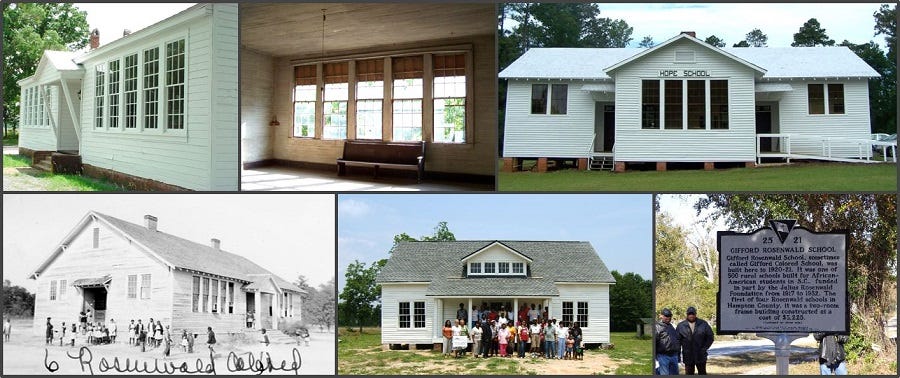
Castle Pinckney (Charleston Harbor)
Early History: Constructed in 1810 on Shutes Folly Island, Castle Pinckney served as a defensive fortification for Charleston Harbor. It was named for Charles Cotesworth Pinckney, a signer of the U.S. Constitution, who ran for president several times, and also happened to be the son of Eliza Lucas Pinckney.
Civil War Use: During the Civil War, it was used to house Union prisoners of war, though it never saw combat. After the Civil War, from 1876-1917, the fort was primarily used as a lighthouse.
Modern Status: Declared a National Monument in 1924, it was later decommissioned and is now maintained by the Castle Pinckney Historical Preservation Society — though the structure is in ruins.

The Carolina Theater (Spartanburg)
Origins: Opened in 1925 as the Montgomery Theater, it was incorporated into the Montgomery Building, a ten-story office complex. The theater boasted an interior box office, chandeliers, 3 levels of seating that included 1,300 seats, and a 36-foot wide proscenium stage “with a trap door and orchestral pit.” From AbandonedSoutheast.com:
“Until the arrival of sound features, the theater offered almost nightly plays, musicals with music by Gershwin, Kern, Friml, and others – as well as frequent performances from Keith Vaudeville from New York. In 1926, the Montgomery installed both Vitaphone and Movietone sound to show the new Vitaphone shorts and newsreels with sound. There was little stir around the venue until 1928 when the Jazz Singer played for a week. Two years later, in 1930, Greta Garbo talked in Anne Christie and a new era had begun. However, throughout the Great Depression years, vaudeville and hour-long revues continued onstage weekly. The theater organ, organ chambers, and associated wiring and air duct lines were incorporated into the design since the theater was intended to be equipped with an organ, but one was never installed. A white grand piano was used in its place…
In 1932, Wilby-Kinsey Theaters took over management and the name was changed to the Carolina Theater. The interior box office was closed and an ornate box office was placed at the Church Street entrance. As the Carolina, it was operated by Paramount’s Publix Theatre chain and once described as “The Finest Theatre in South Carolina.” In February of 1940, the Carolina Theater hosted a week-long engagement of the film Gone with the Wind. The film reached Spartanburg two months after its Atlanta premiere. It was a major event, and Spartanburg High School allowed students to leave early to attend the 2:00 PM matinees. The price of admission was 75 cents…
In 1956, Elvis Presley performed on stage at the Carolina Theater to a packed house. Not long after, a wide rectangular screen was installed on the stage, putting an end to live performances. Although the Carolina Theater went through another renovation in the 1970s, but was unable to maintain a steady customer base and soon after permanently closed its doors. The theater space has sat abandoned for almost 50 years now. Preservationists, historians, and locals believe the theater could once again be restored and serve as an asset to the city.”
Architectural Significance: Designed by Lockwood, Greene & Company, it was considered one of the finest theaters in South Carolina at the time.
Current Status: Though the theater has been closed for years, efforts have been made to preserve the Montgomery Building, which has undergone restoration in recent years.
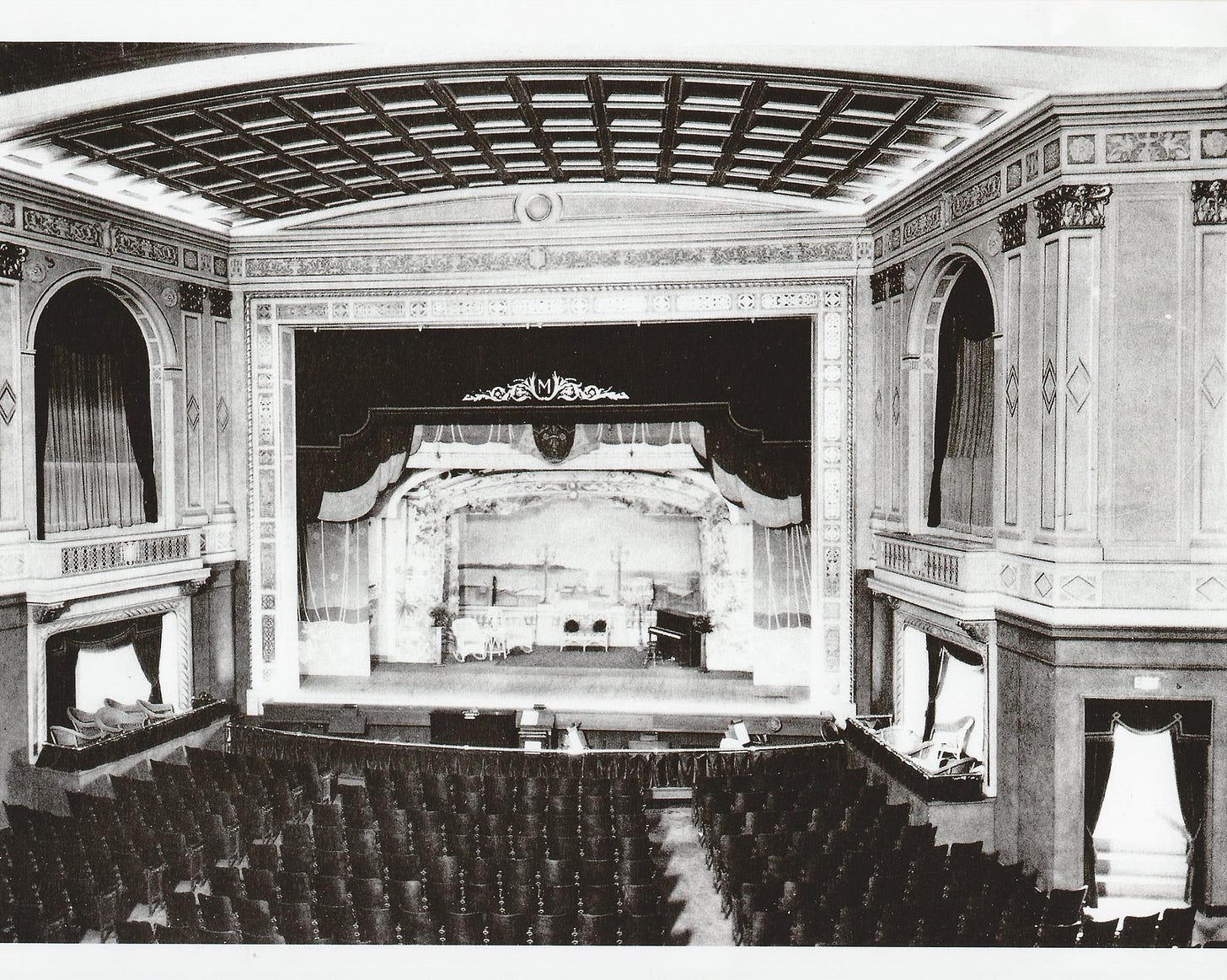
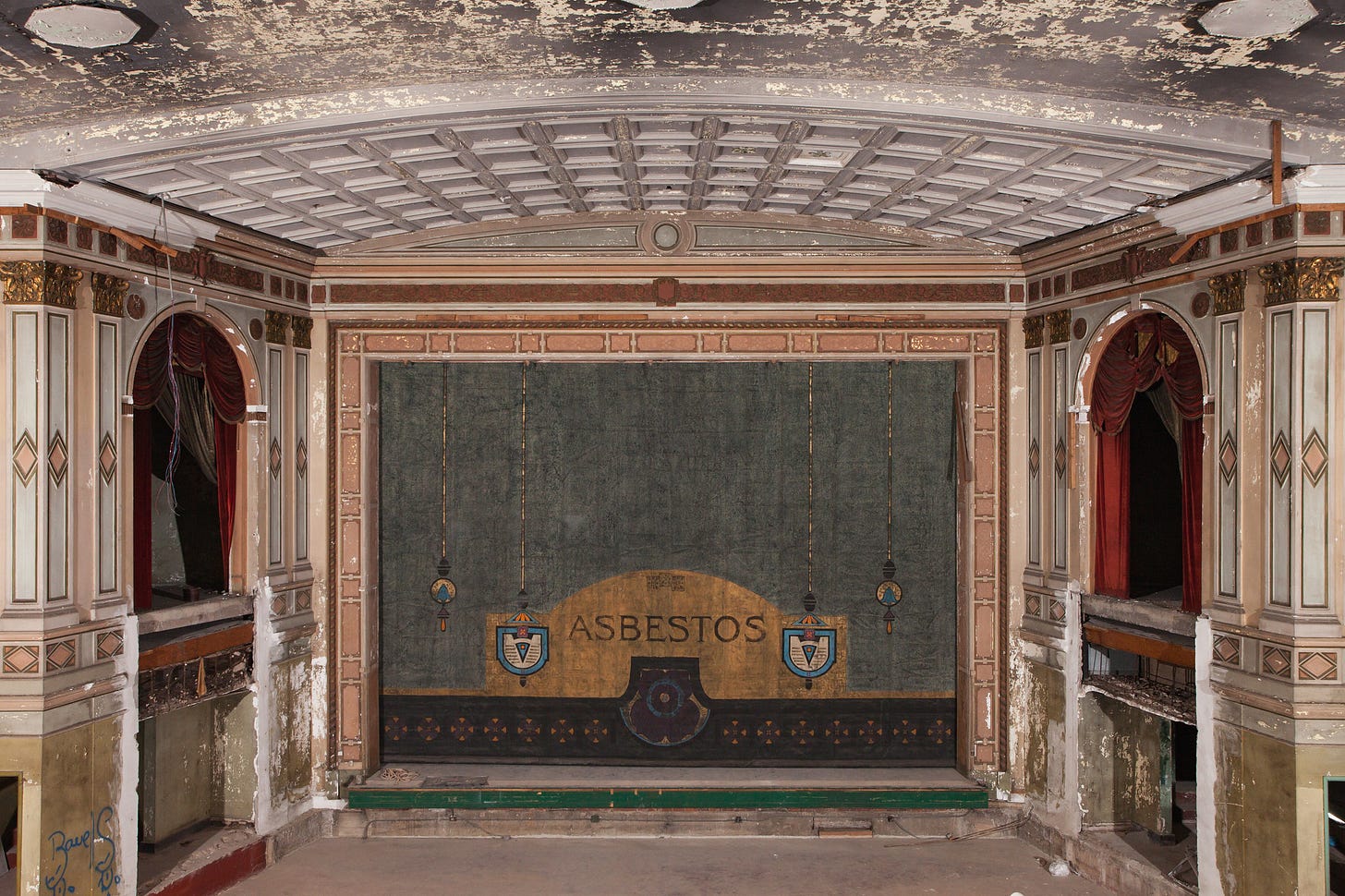
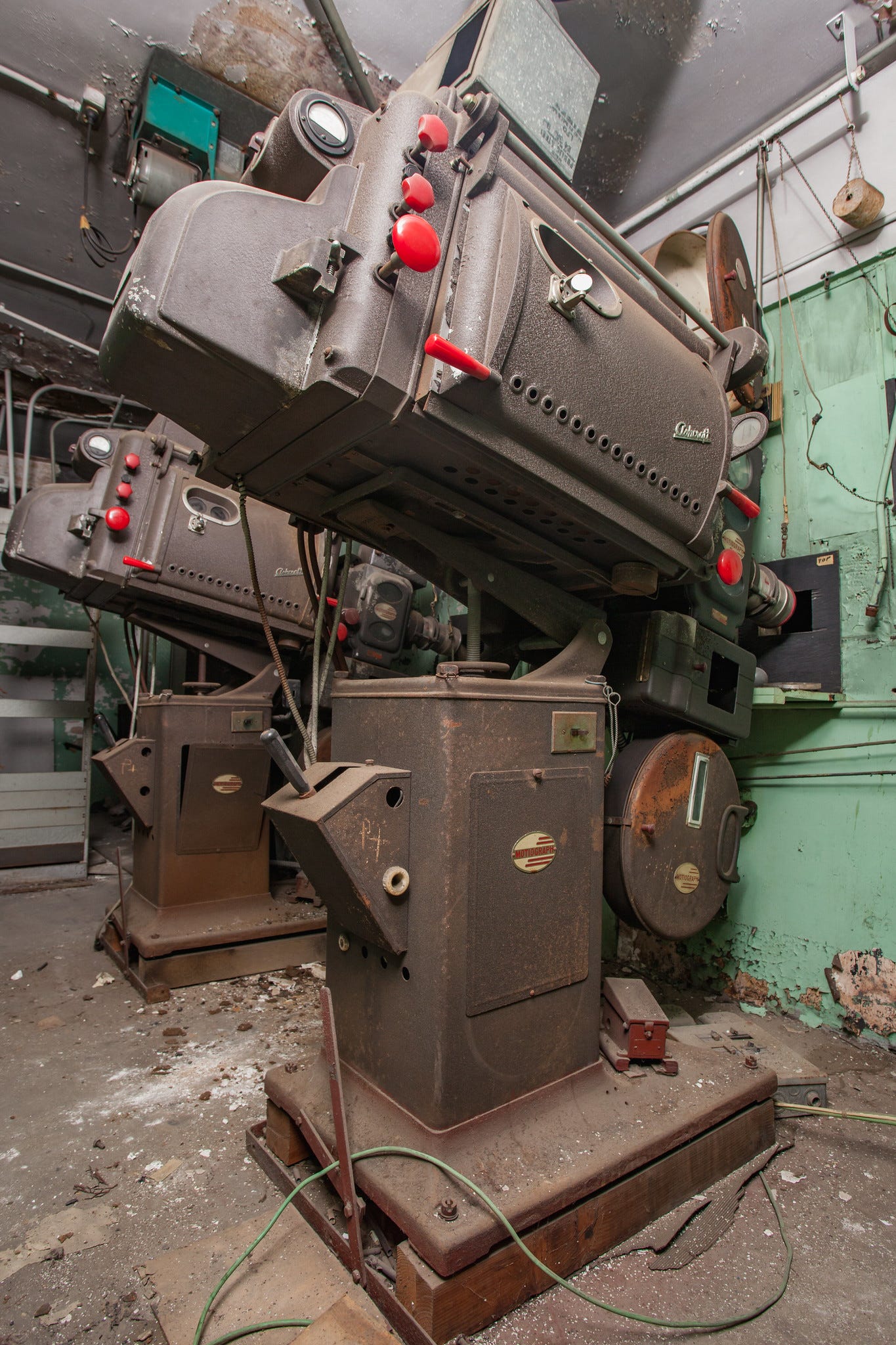
Do you have any family knowledge or memories of any of these demolished or abandoned South Carolina architectural treasures? If so, leave a comment below!
If you voted just “OK” on the newsletter today, I want to hear from you! Reply to this email and send me your feedback. :)
➳ Sources — History of South Carolina Founding Mothers
"Altamont Hotel on Paris Mountain." GVL Today, 6AM City, https://gvltoday.6amcity.com/history/altamont-hotel-paris-mountain-greenville-sc. Accessed 18 May 2025.
"Carolina Theater." Abandoned Southeast, 23 Nov. 2021, https://abandonedsoutheast.com/2021/11/23/carolina-theater/. Accessed 18 May 2025.
"Carolina Theater Restoration." GoUpstate, 4 Oct. 2017, https://www.goupstate.com/story/news/local/2017/10/04/group-focuses-on-carolina-theater-restoration/18642653007/. Accessed 18 May 2025.
"Glimpses of Greenville: Duke's Tea Room." Greenville Journal, https://greenvillejournal.com/history/glimpses-of-greenville-duke-tea-room/. Accessed 18 May 2025.
"Historic Resources of Richland County: Millwood." South Carolina Department of Archives and History, http://www.nationalregister.sc.gov/richland/S10817740013/index.htm. Accessed 18 May 2025.
"Ocean Forest Hotel." Grand Strand Magazine, https://grandstrandmag.com/feature/remembering_myrtle_beachs_ocean_forest_hotel. Accessed 18 May 2025.
"Ottaray Hotel: The Tallest Building in Greenville." Greenville News, 21 Apr. 2017, https://www.greenvilleonline.com/story/news/local/greenville-roots/2017/04/21/ottaray-hotel-greenville-sc/98142458/. Accessed 18 May 2025.
"Rosenwald Schools." South Carolina Department of Archives and History, https://scdah.sc.gov/historic-preservation/resources/african-american-heritage/rosenwald-schools. Accessed 18 May 2025.
"South Carolina’s Abandoned Prison on the Coast." Only In Your State, https://www.onlyinyourstate.com/state-pride/south-carolina/abandoned-prison-coast-sc. Accessed 18 May 2025.
"Wade Hampton III: Born March 28, 1818." Civil War Reflections, 2013, https://civilwaref.blogspot.com/2013/03/wade-hampton-iii-born-march-28-1818.html. Accessed 18 May 2025.






